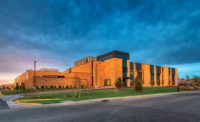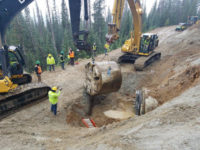2022 ENR Mountain States Best Projects
Best Project, Small Project: High Altitude Research Lab

Photo
High Altitude Research Lab
Colorado Springs
BEST PROJECT
Submitted By: GE Johnson Construction Co.
Owner: U.S. Army Corps of Engineers
Lead Design Firm: RTA Architects
General Contractor: GE Johnson Construction Co.
Civil Engineer: Kiowa Engineering
Structural Engineer: HCDA Engineering
MEP Engineer: Branch Pattern
Precast Concrete Systems: Stresscon Corp.
Electrical: Encore Electric
At more than 14,000 ft, the High Altitude Research Lab is the highest Army Corps of Engineers project in the world, and one of the most remote. Located on the west side of the new Pikes Peak Summit Visitor Center, the medical research facility features a fully functioning dormitory, kitchen and day room for 10 soldiers.
The structure’s intentionally low-profile appearance tucks into the mountain, allowing prominent sightlines to extend over the facility so that visitor center patrons rarely notice it. The design was centered around the maximum size and weight of a precast concrete panel that could be hauled on shorter, specialized trailers capable of managing the switchbacks of the Pikes Peak Highway. The stamped pattern of the 22-in.-thick exterior precast panels resembles the adjacent visitor center’s real stone facade, adding uniformity in the buildings as well as contributing to cost savings.
With arctic conditions penetrating the mountain and causing the bedrock to remain at a temperature of 23°F, the envelope extends under the floor slab of the crawl space, which is fitted with R-40 insulation. The differential of interior and exterior temperatures and the high relative humidity required envelope detailing to focus on the reduction of thermal bridges and maintaining insulation continuity.

Photo by The Unfound door
Protecting the crawl space was key, as it holds storage tanks for the domestic water supply, which is trucked in when conditions permit. The crawl space also stores sanitary wastewater, which is hauled down the mountain to a municipal treatment plant.
During the first winter season, the team determined that working through winter was achievable if the summit highway remained open. Snowplows were deployed full-time to clear roads, escort employees and clear the jobsite. Going the extra mile to prepare for winter construction was paramount, as average winter temperatures at the summit stayed below -20°F. Measures were taken to prevent heavy equipment from freezing during excavation and rock removal. Periodic 160-mph wind gusts blew out the glass on vehicles and equipment.
Lightning storms would move onto the summit with little warning and shut down precast erection for up to an hour every day.




